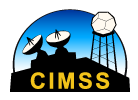GOES-15 Visible (top), Shortwave Infrared (middle) and Infrared Window (bottom) images [click to play animation]
A pyroCb cloud developed from the Maple Fire in far northwestern Wyoming during the late afternoon hours on 15 August 2016; GOES-15 (GOES-West) 0.63 µm Visible, 3.9 µm Shortwave Infrared and 10.7 µm Infrared Window images (above; also available as an MP4) showed the fire hot spot (red pixels on the 3.9 µm images) and the pyroCb cloud (shades of green to yellow on the 10.7 µm images) as it drifted southward then southwestward over far eastern Idaho by 0200 UTC on 16 August.
After sunset, GOES-15 3.9 µm Shortwave Infrared and 10.7 µm Infrared Window images (below; also available as an MP4) showed a gradual decrease in the intensity and areal coverage of the 3.9 µm fire hot spot, along with a continued cooling trend of the 10.7 µm pyroCb cloud-top IR brightness temperatures (which reached -49º C at 0341 and 0345 UTC).
A 4-panel composite of NOAA-18 images at 0146 UTC on 16 August (below; courtesy of Rene Servranckx) depicted a minimum cloud-top IR brightness temperature of -55.5º C, which corresponds to an altitude of 11.5 km according to the 00 UTC Riverton, Wyoming rawinsonde data.
![NOAA-18 Visible (upper left), Shortwave Infrared (upper right), Infrared Window (lower left) and false-color RGB composite (lower right) images [click to enlarge]](http://pyrocb.ssec.wisc.edu/wp-content/uploads/2016/08/20160816_0146utc_N18_ch1_ch3_ch4_ch321.jpg)









![NOAA-18 AVHRR 0.64 µm visible (top left), 3,7 µm shortwave IR (top right), 10.8 µm IR window (bottom left) and false-color RGB composite image (bottom right). [click to enlarge]](http://pyrocb.ssec.wisc.edu/wp-content/uploads/2016/07/20160718_2146utc_N19_ch1_ch3_ch4_ch321.jpg)

![NOAA-18 AVHRR 0.64 µm visible (top left), 3,7 µm shortwave IR (top right), 10.8 µm IR window (bottom left) and false-color RGB composite image (bottom right). [click to enlarge]](http://pyrocb.ssec.wisc.edu/wp-content/uploads/2016/07/160715_0307utc_NOAA-18_ch1_ch3_ch4_ch321.jpg)
![Suomi NPP VIIRS Day/Night Band (0.7 μm), Shortwave Infrared (3.74 μm) and Infrared Window (11.45 μm) images [click to enlarge]](http://pyrocb.ssec.wisc.edu/wp-content/uploads/2016/07/160715_1242utc_suomi_npp_viirs_dnb_ir_swir_AK_fires_anim.gif)
![Suomi NPP OMPS Aerosol Index [click to enlarge]](http://pyrocb.ssec.wisc.edu/wp-content/uploads/2016/07/160715_OMPS_AI_AK_pyroCb_smoke.png)
![CALIPSO CALOIP attenuated backscatter and depolarization data; Alaska pyroCb smoke plume aloft indicated by arrow [click to enlarge]](http://pyrocb.ssec.wisc.edu/wp-content/uploads/2016/07/160715_13utc_caliop_total_backscatter_depole_ratio_AK_pyroCb_smoke_anim.gif)
![Suomi NPP OMPS Aerosol Index images [click to enlarge]](http://pyrocb.ssec.wisc.edu/wp-content/uploads/2016/07/160716_OMPS_AI_AK_fires.jpg)

![Suomi NPP VIIRS shortwave infrared (3.74 µm) and Day/Night Band (0.7 µm) images [click to enlarge]](http://pyrocb.ssec.wisc.edu/wp-content/uploads/2016/07/160711_0859utc_suomi_npp_viirs_Shortwave_IR_Day_night_Band_Colorado_fires_anim.gif)
